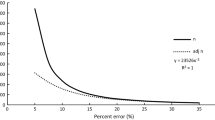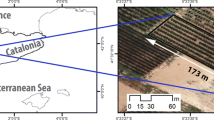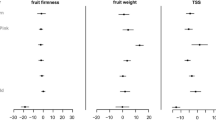Abstract
Early forecasting of fruit orchard yield is important for market planning and for growers and exporters to plan labour, bins, storage and purchase of packing materials. Large variations in tree yield pose a challenge for accurate yield estimation. We evaluated a three-level systematic sampling procedure for unbiased estimation of fruit number for yield forecasts. In the Spring of 2009 we estimated the total number of fruit in several rows of each of 14 commercial fruit orchards growing apple (11 groves), kiwifruit (two groves), and table grapes (one grove) in central Chile. Survey times were 10–100 min for apples (depending on vigour), 85 min for the table grapes, and 85 and 150 min for the kiwifruit. During harvest in the Fall, the fruit were counted to obtain the true number. Yields ranged from lows of several thousand (grape bunches), to highs of more than 40 000 fruit (apples, kiwifruit). Absolute true errors (defined as the absolute difference between the estimate and the true value, divided by the true value) were less than 5% in six orchards, between 5 and 10% in a further five orchards and 13% in one orchard. In two apple orchards we obtained absolute true errors of about 20%. Error analysis based on systematic sub-sampling across each sampling stage was used to determine how to distribute sampling effort to achieve a total coefficient of error of 10%. We discuss the extension of the procedure for yield estimation at the full orchard scale for any target precision.






Similar content being viewed by others
References
Aggelopoulou, K. D., Wulfsohn, D., Fountas, S., Gemtos, T. A., Nanos, G. D., & Blackmore, S. (2010). Spatial variability of yield and quality in a small apple orchard. Precision Agriculture, 11, 538–556.
Alburquerque, N., Burgos, L., & Egea, J. (2004). Influence of flower bud density, flower bud drop and fruit set on apricot productivity. Scientia Horticulturae, 102, 397–406.
Allen, R. D. (1972). Evaluating procedures for estimating citrus fruit yield. Fruit counts, ground photography, remote sensing. Report, Statistical Reporting Service, USDA. Washington, DC: United States Department of Agriculture.
Baddeley, A., & Jensen, E. B. V. (2004). Stereology for statisticians (p. 395). Bacon Raton, FL: Chapman & Hall/CRC.
Best, S., & Zamora, I. (2008). Tecnologías aplicable en agricultura de precisión. Use de tecnología de precisión en evaluación, diagnóstico y solución de problemas productivos (p. 98). Santiago de Chile: Fundacion para la Innovacion Agraria (FIA).
Bramley, R. G. V. (2001). Vineyard sampling for more precise, targeted management. In Proceedings of the 1st Australian geospatial information and agriculture conference (pp. 417–427). Sydney, Australia: University of Sydney. ISBN 1-876346-32-9.
Clingeleffer, P. (2001). Crop development, crop estimation and crop control to secure quality and production of major wine grape varieties: A national approach (p. 148). Final report to the Grape and Wine Research Development Corporation for Project CSH 96/1. Goodwood, Southern Australia: GWRDC.
Cruz-Orive, L. M. (1990). On the empirical variance of a fractionator estimate. Journal of Microscopy, 160, 89–95.
Cruz-Orive, L. M. (2004). Precision of the fractionator from Cavalieri designs. Journal of Microscopy, 213, 205–211.
Dami, I. (2006). Methods of crop estimation in grapes. http://www.oardc.ohio-state.edu/grapeweb/OGEN/07262006/CropEstimation06.pdf. Accessed 17 March 2011.
Doraiswamy, P. C., Akhmedov, B., Beard, L., Stern, A., & Mueller, R. (2006). Operational predictions of crop yields using MODIS data and products. In B. Baruth, A. Royer, & G. Genovese (Eds.), ISPRS archives XXXVI-8/W48 workshop proceedings: Remote sensing support to crop yield forecast and area estimates (pp. 45–49). Ispra, Italy: Joint Research Centre.
Dunn, G. M. (2010). Yield forecasting. GWRDC fact sheet, June 2010. Goodwood, South Australia: Grape and Wine Research and Development Corporation. http://www.gwrdc.com.au/webdata/resources/factSheet/. Accessed 16 March 2011.
Dunn, G. M., & Martin, S. R. (1998). Optimising vineyard sampling to estimate yield components. The Australian Grapegrower and Winemaker—Annual Technical Issue, 414a, 102–107.
Dunstone, R. J., Dunn, G. M., Martin, S. R., Whiting, J. R., & Mahoney, C. (2005). Realistic considerations for technology adoption—a wine industry example. Acta Horticulturae, 694, 351–355.
European Commission. (2010). Commission staff working document accompanying document to the report from the Commission to the European Parliament and the Council on the experience acquired from the statistical survey on plantations of certain species of fruit trees, carried out by the Member States in 2007 in application of Directive 2001/109/EC of the European Parliament and of the Council of 19 December 2001. http://eur-lex.europa.eu/LexUriServ/LexUriServ.do?uri=CELEX:52010SC0776:ES:NOT. Accessed 23 March 2011.
Fletcher, R. S., Escobar, D. E., & Skaria, M. (2004). Evaluating airborne normalized difference vegetation index imagery for citrus orchard surveys. HortTechnology, 14, 91–94.
Garcia-Fiñana, M., & Cruz-Orive, L. M. (2004). Improved variance prediction for systematic sampling on R. Statistics, 38, 243–272.
Gardi, J. E., Wulfsohn, D., & Nyengaard, J. R. (2007). A handheld support system to facilitate stereological measurements and mapping of branching structures. Journal of Microscopy, 227, 124–139.
Gregoire, T. G., Valentine, H. T., & Furnival, G. M. (1995). Sampling methods to estimate foliage and other characteristics of individual trees. Ecology, 76, 1181–1194.
Gundersen, H. J. G. (1986). Stereology of arbitrary particles. A review of unbiased number and size estimators and the presentation of some new ones, in memory of William R. Thompson. Journal of Microscopy, 143, 3–45.
Hall, A., Lamb, D. W., Holzapfel, B. P., & Louis, J. P. (2011). Within-season temporal variation in correlations between vineyard canopy and winegrape composition and yield. Precision Agriculture, 12, 103–117.
Ingels, C., Geisel, P. M., & Unruh, C. L. (2002). Fruit trees: Training and pruning deciduous trees. ANR publication no. 8057. Oakland: University of California, Division of Agriculture and Natural Resources.
Jessen, R. J. (1955). Determining the fruit count on a tree by randomized branch sampling. Biometrics, 11, 99–109.
Johnson, L. F., Roczen, D. E., Youkhana, S. K., Nemani, R. R., & Bosch, D. F. (2003). Mapping vineyard leaf area with multispectral satellite imagery. Computers and Electronics in Agriculture, 38, 33–44.
Lauri, P. E. (2000). The vertical axis and Solaxe systems in France. Acta Horticulturae, 513, 287–296.
Lötze, E., & Bergh, O. (2004). Early prediction of harvest fruit size distribution of an apple and pear cultivar. Scientia Horticulturae, 101, 281–290.
Maletti, G. M., & Wulfsohn, D. (2006). Evaluation of variance models for fractionator sampling of trees. Journal of Microscopy, 222, 228–241.
Mann, K. K., Schumann, A. W., & Obreza, T. A. (2011). Delineating productivity zones in a citrus grove using citrus production, tree growth and temporally stable soil data. Precision Agriculture, 12, 457–472.
Paltineanu, Cr., & Chitu, E. (2006). An estimation model of the climatic rating in the ‘Golden Delicious’ apple cultivar in the southern part of Romania. Acta Horticulturae, 707, 119–125.
R Development Core Team. (2009). R: A language and environment for statistical computing. Vienna, Austria: R Foundation for Statistical Computing.
Rowe, R. N., & Johnson, R. (1992). The interactions between fruit number, tree size and the yield and fruit size of Fantasia nectarine. Acta Horticulturae, 315, 171–176.
Sakai, K., Noguchi, Y., & Asada, S. I. (2008). Detecting chaos in a citrus orchard: Reconstruction of nonlinear dynamics from very short ecological time series. Chaos, Solitons & Fractals, 38, 1274–1282.
Sale, P. R., & Lyford, P. B. (1990). Cultural, management and harvesting practices for kiwifruit in New Zealand. In I. J. Warrington & G. C. Weston (Eds.), Kiwifruit science and management (pp. 247–296). Auckland, New Zealand: Ray Richards Publisher.
Shields, D. A. (1992). USDA’s method of estimating fruit and tree nut production—United States Department of Agriculture—U.S. Dept. of Agriculture, Economic Research Service report. Situation and outlook report: Fruit and tree nuts. http://findarticles.com/p/articles/mi_m3837/is_1992_March/ai_12189447/. Accessed 18 March 2011.
Stout, R. G. (1962). Estimating citrus production by use of frame count survey. Journal of Farm Economics, 44, 1037–1049.
Stuart, A. (1984). The ideas of sampling (3rd ed., p. 91). New York: MacMillan Publishing Company.
Tarara, J. M., Ferguson, J. C., Blom, P. E., Pitts, M. J., & Pierce, F. J. (2004). Estimation of grapevine crop mass and yield via automated measurements of trellis tension. Transactions of the ASAE, 47, 647–657.
Thompson, S. K. (1992). Sampling (p. 343). New York: Wiley.
USDA NASS. (2009). Forecasting Florida’s citrus production. Maitland, FL: United States Department of Agriculture, National Agricultural Statistics Service, Florida Field Office. http://www.nass.usda.gov/Statistics_by_State/Florida/Publications/Citrus/broc/0708broc.pdf. Accessed 1 March 2011.
Vintila, R., & Baret, F. (2006). An optimal temporal resolution of multispectral satellite data for field scale agriculture. In B. Baruth, A. Royer, & G. Genovese (Eds.), ISPRS archives XXXVI-8/W48 workshop proceedings: Remote sensing support to crop yield forecast and area estimates (pp. 139–141). Ispra, Italy: Joint Research Centre.
Warren, F. B., & Wigton, W. H. (1971). Sampling for objective yields of apples and peaches, Virginia 1967-68. Unpublished report. Washington, DC: USDA Statistical Reporting Service.
Winter, F. (1976). A simulation model for studying the efficiency of apple and pear orchards. Gartenbauwissenschaft, 41, 26–34.
Wolpert, J. A., & Vilas, E. P. (1992). Estimating vineyard yields: Introduction to a simple, two-step method. American Journal of Enology and Viticulture, 43, 384–388.
Wolter, K. M. (1985). Introduction to variance estimation (p. 427). New York: Springer-Verlag.
Wulfsohn, D. (2010). Sampling techniques for plants and soil. In S. K. Upadhyaya, D. K. Giles, S. Haneklaus, & E. Schnug (Eds.), Advanced engineering systems for specialty crops: A review of precision agriculture for water, chemical, and nutrient application, and yield monitoring. Landbauforschung Völkenrode, Special Issue 340, 3–30. Braunschweig: Johan Heinrich von Thunen-Institut
Wulfsohn, D., Maletti, G. M., & Toldam-Andersen, T. B. (2006). Unbiased estimator for the total number of flowers on a tree. Acta Horticulturae, 707, 245–252.
Wulfsohn, D., Sciortino, M., Aaslyng, J. M., & García-Fiñana, M. (2010). Nondestructive, stereological estimation of canopy surface area. Biometrics, 66, 159–168.
Acknowledgment
We express our appreciation to all the fruit producers who collaborated in this study and to Dayenu Ltda. MGF and DW also acknowledge support from the Royal Society Joint Project No. 2008/R1, and the Ministry of Science and Innovation (Madrid) I+D+i Project MTM-2009-14500-C02-01. We thank the two anonymous referees for valuable comments.
Author information
Authors and Affiliations
Corresponding author
Rights and permissions
About this article
Cite this article
Wulfsohn, D., Aravena Zamora, F., Potin Téllez, C. et al. Multilevel systematic sampling to estimate total fruit number for yield forecasts. Precision Agric 13, 256–275 (2012). https://doi.org/10.1007/s11119-011-9245-2
Published:
Issue Date:
DOI: https://doi.org/10.1007/s11119-011-9245-2




